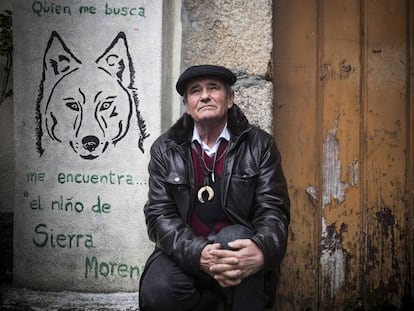Loved and feared: Spain’s complicated relationship with wolves
EL PAÍS talks to a Swedish sociologist who has been traveling across a country that is a perfect case study in the difficulties of coexistence between humans and these carnivores in Europe

Like an intrepid 18th-century explorer or a curious Hispanist, the Swedish sociologist Hanna Pettersson, 29, has been traveling to rural areas in Spain where the return of the Iberian wolf has already led to conflict with local communities, or could do so in future.
“The news traveled quickly. In many places, they already knew that a blue-eyed Swede was coming to ask questions,” she says in near-perfect Spanish. Everywhere she went, she began by going to the village bar to speak with the locals over coffee or a glass of wine, and it was these conversations that laid the seeds for Pettersson’s doctoral thesis: the future of the conflict and coexistence between humans and carnivores in Europe.
The conflicts with wolves symbolize many other conflicts: the disconnection between the urban and rural worldsSwedish sociologist Hanna Pettersson
Pettersson is studying human ecology at Leeds University in the United Kingdom, a subject that looks at the interaction of people with nature. In the last few months she has been traveling across the Spanish geography: she has been to the mountains of Culebra in Zamora and to Gredos in central Spain, to the Picos de Europa mountain range in the north, and to La Vera in the eastern province of Cáceres.
“Depopulation and other factors mean that large carnivores are once again in contact with humans across Europe,” she says. And this contact can lead to conflict. Wolves are advancing from their main strongholds in the northeast, and entering the countryside of Spain’s deserted interior. Indeed, Spain has all the factors to make a perfect case study: depopulation, extensive pastoral farming and large carnivores – the Iberian wolf. “I am interested in understanding why some places coexist well with wolves and others don’t,” she explains. Pettersson wants to find solutions to these conflicts.
The number of large wild animals is declining dramatically across the world – populations have fallen by 68% since 1970, according to the conservation organization World Wide Fund for Nature (WWF). But locally the situation is more complicated. For example, during Spain’s strict coronavirus lockdown in spring, groups of wild boars ventured into urban areas. “When people disappear, the woods move in,” says Pettersson. Some people see wolves as a threat, others as a tourist attraction, and then there are those who appreciate their environmental value. Wolves are admired for their beauty, mystery, independence and near-mythical status, but they also inspire fear and hate due to their attacks on livestock.

“The conflicts with wolves symbolize many other conflicts: the disconnection between the urban and rural world, a polarization that is seen in other aspects of society, the friction between authorities and the countryside, or the precarious conditions of traditional livestock breeders,” says Pettersson. She hopes that her doctoral thesis will break some of these stereotypes: not all urbanites and conservationists defend wolves at all costs, nor do all ranchers want them to be exterminated. “The media presents this as a very passionate conflict, but it is filled with nuance,” she explains.
What’s more, in many places wolves are a big tourist attraction and play an important role in maintaining the stability of ecosystems. “If livestock breeders did not have such small profit margins, they would not be so vulnerable to wolf attacks and would be able to pay for protection or cover the losses,” says Pettersson, who is the daughter of a livestock breeder herself, which helped her gain the trust of those in Spain. “Farmers also care for their animals. We have to prevent attacks by all means possible. In some areas, it is possible to use mastiffs and in others, different solutions must be found,” she adds.
But there are no magic solutions. “It’s necessary to promote and recognize the places where there is a good coexistence [between wolves and humans] and not only focus on the ones where there is conflict, which is where resources and attention tend to be focused,” argues Pettersson. During her time in Spain, the sociologist visited schools, attended meetings and protests, and entered people’s kitchens that she left with bags of vegetables as parting gifts. After this experience, much observation and nearly 100 interviews, Pettersson has come to appreciate the traditions that are kept alive in Spain’s rural areas. “In my country, almost all the customs and knowledge linked to the countryside are disappearing. It is all very industrialized,” she says.
English version by Melissa Kitson.
Tu suscripción se está usando en otro dispositivo
¿Quieres añadir otro usuario a tu suscripción?
Si continúas leyendo en este dispositivo, no se podrá leer en el otro.
FlechaTu suscripción se está usando en otro dispositivo y solo puedes acceder a EL PAÍS desde un dispositivo a la vez.
Si quieres compartir tu cuenta, cambia tu suscripción a la modalidad Premium, así podrás añadir otro usuario. Cada uno accederá con su propia cuenta de email, lo que os permitirá personalizar vuestra experiencia en EL PAÍS.
¿Tienes una suscripción de empresa? Accede aquí para contratar más cuentas.
En el caso de no saber quién está usando tu cuenta, te recomendamos cambiar tu contraseña aquí.
Si decides continuar compartiendo tu cuenta, este mensaje se mostrará en tu dispositivo y en el de la otra persona que está usando tu cuenta de forma indefinida, afectando a tu experiencia de lectura. Puedes consultar aquí los términos y condiciones de la suscripción digital.
More information
Últimas noticias
The complicated life of Francesca Albanese: A rising figure in Italy but barred from every bank by Trump’s sanctions
Reinhard Genzel, Nobel laureate in physics: ‘One-minute videos will never give you the truth’
Pinochet’s victims grapple with José Antonio Kast’s rise in Chile
How Japan is trying to avert ‘digital defeat’
Most viewed
- Pablo Escobar’s hippos: A serious environmental problem, 40 years on
- Reinhard Genzel, Nobel laureate in physics: ‘One-minute videos will never give you the truth’
- Why we lost the habit of sleeping in two segments and how that changed our sense of time
- Charles Dubouloz, mountaineering star, retires at 36 with a farewell tour inspired by Walter Bonatti
- The Florida Keys tourist paradise is besieged by immigration agents: ‘We’ve never seen anything like this’











































